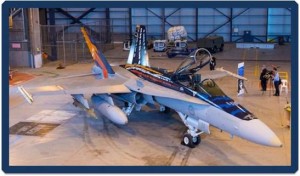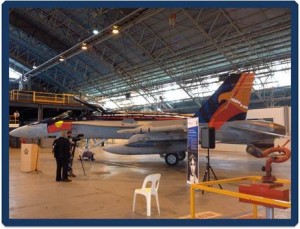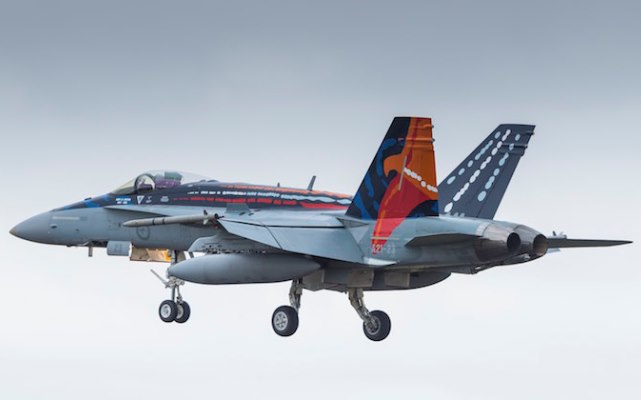Link to YouTube video of the Unveiling
The Royal Australian Air Force showed its appreciation and commitment to the past service and sacrifices of Aboriginal and Torres Strait Islander people with the unveiling of the ‘Worimi’ F/A-18A Hornet on February 24.
Chief of Air Force Air Marshal Geoff Brown was given the honour of unveiling the aircraft with its new attire in front of the family of WOFF Len Waters – Air Force’s first known Aboriginal fighter pilot – 2 invited Elders of the Worimi and assembled guests and more than 20 students of the Indigenous Pre-Recruitment course.


Held in a hangar at Avalon during the Australian International Airshow, the aircraft’s unique colour scheme was stencilled with WOFF Water’s pilot markings and the livery was designed by Australian design studio Balarinji. The artwork depicts a Kilyarr Kilyarr, the Wedgetail Eagle, a powerful bird of prey which dominates the skies over Australia’s land and seascapes. WOFF Water’s younger brother, Len and Len’s son, Glen, were in attendance on behalf of the Waters family and said how honoured they were to be there.
“It was a privilege and a wonderful occasion,” he said. “It was a very important day for our family and it meant a lot to have the aircraft named after him. It was unbelievable.” Mr Waters said Len always loved aircraft and was constantly building them – a foretaste of what was to come. “He loved flying and always did,” he said. “His head was always in the clouds. I wished his wife, Gladys, could have been here but she was too ill to travel from Brisbane. I congratulate the Air Force for putting this on for us.” In unveiling the Worimi Hornet, AIRMSHL Brown said it honoured the traditional owners of the land on which RAAF Base Williamtown now sits.
“This initiative expresses Air Force’s commitment to embracing Aboriginal and Torres Strait Islander history, culture and contribution,” he said. “Air Force values the diversity of all our people, and this aircraft is a way to recognise Indigenous inclusion in a significant way. “Our people are our greatest asset for delivering air power. If we better understand, value and benefit from our collective diversity, Air Force will be a better organisation where people feel valued for their contribution to air power.” Director Aboriginal and Torres Strait Islander Affairs – Air Force Group Captain Lisa Jackson-Pulver, said how personally touched she was with the unveiling.
“I never would have dreamt as a little girl that I would be standing in front of such distinguished people and doing something vitally important to the psyche and spirit of the Air Force,” she said.
Neville Lilley, an elder from the Worimi community at Port Stephens said the Worimi Hornet was a strong indication that Air Force was serious about acknowledging and respecting indigenous history and culture.
“Our people count it as a tremendous honour and privilege,” he said. “When the story is told about the Worimi aircraft and why it is painted in aboriginal colours, it will not only be a thrill and honour to the Worimi people who hear it but to all Aboriginals.” The efforts of CO 81WG Wing Commander David Warren and the combined workshops and ancillary maintenance section and RAAF Base Williamtown were acknowledged during the unveiling.
The livery took 400 individual motifs, done by hand-applied stencils.



